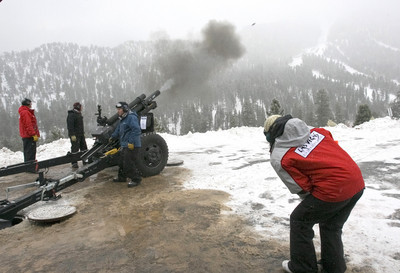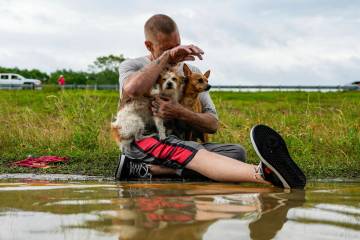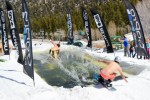Ski resort brings in big gun
With a thunderous "ka-boom," a 1943 Army howitzer sent a bullet the size of a wine bottle hurtling through Sunday morning's dull, overcast sky toward the snow-covered rim of Mount Charleston's Lee Canyon.
Eight seconds later, the 36-pound steel projectile struck a drift of fresh snow and exploded high above the Las Vegas Ski and Snowboard Resort, commencing the first avalanche control mission of the season by a local civilian artillery team.
The team led by Josh Bean, Luke Ham and Brian Strait, the resort's president and general manager, had spent more than an hour in the early morning darkness preparing for the shot and 15 others that would follow.
Their goal was to try to ensure that the mountain was safe for hundreds of skiers and snowboarders who would arrive at the resort's parking lot minutes after the last shot was fired.
"Front clear. Rear clear. All clear," they shouted to each other and the crew that had loaded the 105 mm shell casing capped with the projectile and carefully inserted the round into the breech.
Then, with the command, "Ready to fire," Ham, the resort's snow safety supervisor and assistant gunner, steadily pulled the lanyard until the howitzer erupted with a cloud of black smoke as the projectile flew out the barrel and arched for its target.
Because of low visibility, the shot's effect couldn't be confirmed with binoculars. He would trek to the target site to make sure that any windblown snow mass that had accumulated from the 9 inches that had fallen overnight had been defused of any avalanche danger.
The first shot at 7:44 a.m. marked the culmination of nearly two years of work, hundreds of hours of training and cooperation among the resort, the Army and the U.S. Forest Service in the aftermath of the fatal 2005 avalanche, described by Strait as "an unprecedented event of unprecedented magnitude."
The avalanche on Jan. 9, 2005, sent a 10- to 20-foot-high wave of snow cascading down the mountain, witnesses said. It plucked 13-year-old snowboarder Allen Brett Hutchison of Las Vegas from his seat on a chairlift. His body was found about six hours later buried under 7 feet of snow.
The tragedy prompted the resort to hire two separate industry experts to assess how to control avalanches
"They both concluded the best solution was artillery," Strait said.
With that, the resort succeeded in becoming one of a few in the country where the Army has loaned howitzers to the Forest Service under special use permits.
"There is a very small, select group of ski areas that have a bona fide need to have a piece of artillery for avalanche control," he said.
The Las Vegas Ski and Snowboard Resort became the 11th member of what's called the Avalanche Artillery Users of North America Committee. The other 10 are Alpental, Wash., Alpine Meadows, Calif., Kirkwood, Calif., Mammoth, Calif., Alyeska, Alaska, Bridger Bowl, Mont., Jackson Hole, Wyo., Taos, N.M., Snowbird, Utah, and Alta, Utah.
The director of the Forest Service's National Avalanche Center oversees the entity.
Strait said artillery was first used for avalanche control in 1949 at a ski area at Utah's Little Cottonwood Canyon by soldiers from the 10th Mountain Division. Its success was later demonstrated at other high-risk areas.
He said two howitzers have been operated by his resort. The first was set up in mid-January last year but was transferred in October for use at Sylvan Pass at the east entrance to Yellowstone National Park.
The 4,980-pound howitzer that was fired Sunday came to the resort in late January 2007 from the Sierra Army Depot's inventory. It was set up in the third week of February, but its use was limited because of last year's lean snowfall.
The howitzer was refurbished at the Marine Corps Logistics Base in Barstow, Calif., inspected at the Nevada National Guard's armory in Clark County and fired in October at the Nellis Air Force Base training range.
The howitzer has a range of 12,330 yards, and each 36-pound projectile includes five pounds of explosive compound.
It is calibrated to fire from a specific location in the resort's upper parking lot. Coordinates for the 16 target sites are predetermined, and the accuracy of the shots hinges on the crew's skill in aligning the gun with a nearby stationary post.
"That's the way it works. It's just that easy," Strait said.
The positioning is checked and double-checked. Before each avalanche control mission takes place, a safety briefing is held, and the crew goes through a 41-item checklist to inspect the howitzer.
Strait said the team has "a high comfort level to target the hazard areas."
"Our confidence level is very high," he said. "That's not to say it's a guarantee. Snow is still snow."
Contact reporter Keith Rogers at krogers@reviewjournal.com or (702) 383-0308.






























